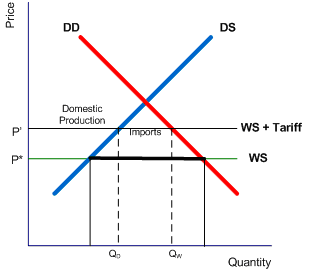I know. I know. I know what your probably saying to yourself. “Not another economics lesson, you nerd!” “Haven’t you already covered everything economics?” Thank you, I am a nerd and also yes I’m thorough in my coverage of topics. I promise I’ll try to not to drone on for 2000 words this time. I need to explain something that President Trump has recently brought up as a potential policy. I don’t think people really understand how import and export tariffs work.
On the surface, in simplest terms a tariff doesn’t sound like a bad thing. A tariff is a tax on a imported or exported good. A tariff can increase of the price of a foreign good to make the domestic goods more “competitive”. Now I put that quotes because the reality is quite different. I think most people would say that there seems to be nothing wrong that. History would even agree that tariffs are a commonly used tool by governments to help guide trading between nations. Here is the problem.
Tariffs are antiquated. The US government used tariffs from its inception thanks to Alexander Hamilton’s brilliant mind to about 1913. After 1913 and in the 105 years since tariffs have fallen out of favor as economic tool. This isn’t to say that no country uses them but the US government only takes about 1-2 percent of its income from tariffs today. Before 1913, the tariff brought in nearly 90 percent of the governments income at its peak.
Economists agree that tariffs hurt an economy. I’ll get to why after I explain that globalization and free trade have changed the world economy. Globalization is the free movement of people, cultural and products. The world is more accessible than ever, with cheap flights to almost anywhere in the world. The internet has an untold wealth of information that was never available til about 25 years ago. We live in a world where everyone is connected. There are multiple free trade agreements between countries that allow a flow of goods and services between them. Free Trade encourages competition in the market. It allows every participant country’s economy to benefit.
Meanwhile, Protectionist economies or countries that use tariffs extensively are actually hinder. The simple explanation through some graphs and pictures. 
This graph is basically a supply and demand curve with some with other lines. (Charts reads likes this: As supply goes up, Demand goes down OR As demand goes up, supply goes down). The bold line is the price of goods before the tariff on imports, its label WS. The line above that labeled WS+ Tariff is price of imports after the tariff. The implication is obvious: A tariff will increase price of an imported good. Here is another chart to show the impact of this:

This particular chart shows the “Dead weight” or loss of value. This chart reads like this: As quantity goes up, the price goes down. You can see the supplier has to pay the tariff and therefore it increase the cost to the customer. The loss of value is where the maker increases the price of their product to cover the cost of the tariff. The money is lost because the supplier has to either stick with that supplier or go to another one which obvious wasn’t cheaper before the tariff.
Here’s an example:
Before Tariff:
Company A: Product cost: 25 dollars
Foreign Supplier 1: Material cost: 5 dollars
Domestic Supplier 2 Material cost: 13 dollars
After Tariff:
Company A: Product cost: $25+ $10 tariff = $35
Foreign Supplier 1: Material Cost: $5 + $10 tariff = 15 dollars
Domestic Supplier 2: Material Cost: 13 dollars (No added Tariff)
You can see the dead weight or loss value. The tariff raises the price of the foreign competitor’s material cost artificially. The extra 10 dollars that it cost to buy from that foreign supplier is lost. This is because the domestic supplier’s cost is 13 dollars compared to the foreign supplier’s 5 dollars before tax. The loss of value is 8 dollars. Therefore the Company A has to raise it prices because its cost have increased.
I’ll put a picture in the preview that help explain even more. (Credit to marketbusinessnews.com)
My conclusion is basically that protectionist policies don’t benefit an economy in the long run. The government is once again interfering in the market where it doesn’t need to be. As usual, the best solution to fix the problem with tariffs is to not have any. We have to take the government out of the market that includes all varies regulations that just raise prices and don’t involve health and safety.
President Trump should tread carefully because the long term implications will be worse than the short term benefits. I think that because of globalization, free trade is the new way to do business. Although the US has historically been a protectionist country, the future is going the exact opposite way. The world economy has undergone globalization and free trade is the new normal.
Thanks for reading, if you are still awake feel free to check out:
Facebook: Garrett’s Life Experience’s
Twitter @gpslife12
Have an awesome day!
Relevant articles on Tariffs, Historical Tariffs, Economics Part 1, Part 2, Part 3


